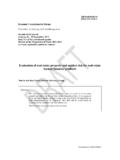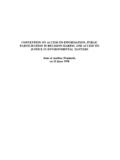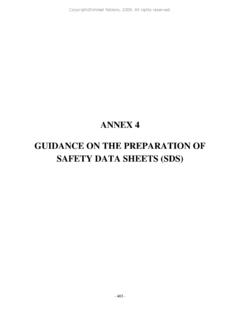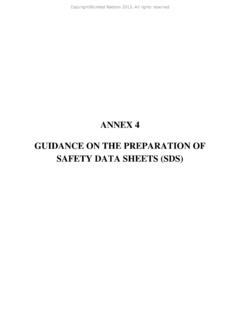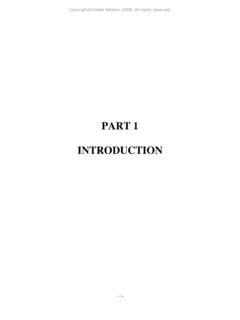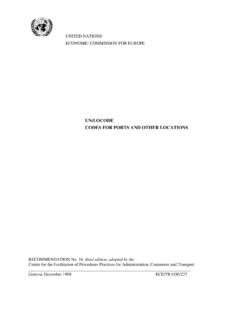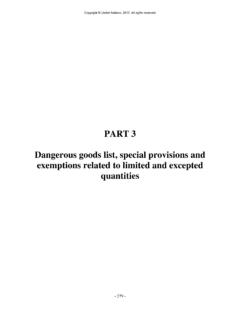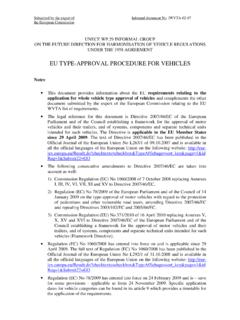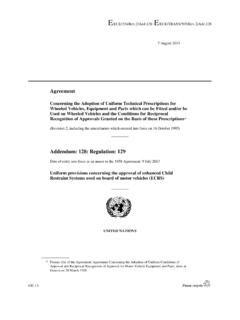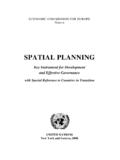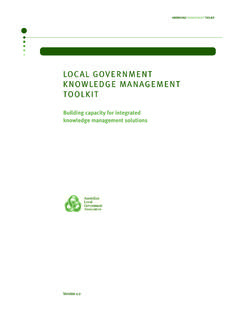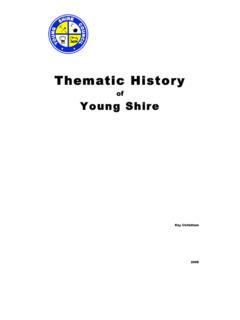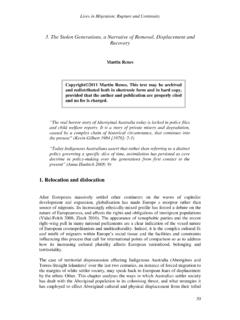Transcription of Making Data Meaningful - UNECE
1 UNITED NATIONS ECONOMIC COMMISSION FOR EUROPE Making data Meaningful part 2: A guide to presenting statistics UNITED NATIONS Geneva, 2009 NOTE The designations employed and the presentation of the material in this publication do not imply the expression of any opinion whatsoever on the part of the Secretariat of the United Nations concerning the legal status of any country, territory, city or area, or of its authorities, or concerning the delimitation of its frontier or boundaries. ECE/CES/STAT/NONE/2009/3 iii Table of Contents .. Introduction ..v 1. Getting the message across .. 1 2. Visualization of statistics .. 7 3. Tables .. 12 4. Charts .. 17 5. Maps .. 30 6. Emerging visualization techniques .. 41 7. Accessibility issues .. 46 8. References and further reading .. 51 Making data Meaningful part 2: A guide to presenting statistics v Introduction The Making data Meaningful guides have been prepared within the framework of the United Nations Economic Commission for Europe ( UNECE ) Work Sessions on the Communication and Dissemination of Statistics1, under the programme of work of the Conference of European Statisticians2.
2 These guides are intended as a practical tool to help managers, statisticians and media relations officers in statistical organizations, particularly those organizations that are in the process of developing their communication strategies. The guides provide advice on the use of text, tables, charts, maps and other devices to bring statistics to life for non-statisticians. They contain suggestions, guidelines and examples - but not strict rules or rigid templates. An effective data release uses a combination of text, tables and graphics to maximize its strength in conveying various types of information. Making data Meaningful part 1: A guide to writing stories about numbers (issued in 2006) focused on the use of effective writing techniques. Making data Meaningful part 2: A guide to presenting statistics aims to help readers find the best way to get their message across to non-specialists, using the most suitable set of tools and skills now available from a dazzling array of communication methods.
3 This guide recognizes that there are many practical and cultural differences among statistical organizations and that approaches may vary from country to country. A group of experts in the communication and dissemination of statistics prepared this guide. They are (in alphabetical order): Petteri Baer, UNECE Colleen Blessing, United States Energy Information Administration Eileen Capponi, Organisation for Economic Co-operation and Development Jer me Cukier, Organisation for Economic Co-operation and Development Kerrie Duff, Australian Bureau of Statistics John Flanders, Statistics Canada Colleen Flannery, United States Census Bureau Jessica Gardner, UNECE Martine Grenier, Statistics Canada Armin Grossenbacher, Swiss Federal Statistical Office David Marder, United Kingdom Office for National Statistics Kenneth Meyer, United States Census Bureau Terri Mitton, Organisation for Economic Co-operation and Development Eric St.
4 John, Statistics Canada Thomas Schulz, Swiss Federal Statistical Office Anne-Christine Wanders, UNECE The contributions of Martin Lachance (Statistics Canada), Andrew Mair (Australian Bureau of Statistics), Alan Smith (United Kingdom Office for National Statistics), Christina O Shaughnessy and Steven Vale ( UNECE ) are greatly appreciated. 1 Information about the UNECE Work Sessions on the Communication and Dissemination of Statistics are available from the UNECE website at 2 Information about the Conference of European Statisticians is available from the UNECE website at Making data Meaningful part 2: A guide to presenting statistics 1 1. Getting the message across The written word News releases are often the vehicle through which your statistical organization communicates key findings of its statistical and analytical programmes to the intended audience, which is most probably the general public.
5 The text is the principal vehicle for explaining the findings, outlining trends and providing contextual information. In this chapter, we will provide many suggestions for preparing an effective news release or other document, such as a report or an analytical article. What makes a news release, report or analytical article effective? Perhaps the best explanation comes from the first Making data Meaningful guide, part 1: A guide to writing stories about numbers, which provides an initial set of recommendations for getting your message across. An effective news release is one that: tells a story about the data ; has relevance for the public and answers the question Why should my audience want to read about this? ; catches the reader's attention quickly with a headline or image; is easily understood, interesting and often entertaining; encourages others, including the media, to use statistics appropriately to add impact to what they are communicating.
6 Here are some tips to help you get started on your text. Target audience: your first decision The first important decision you must make is to pinpoint an audience: who are you writing for? Quite simply, the audience is in the driver's seat. By and large, what the audience wants is what you should be giving them. You have to listen to your audiences to find and select the right narratives, language, and visual and graphic devices that will capture their attention. The choice of an audience is more complex these days because of the Internet. Most statistical organizations have a mandate to communicate to the general public, who are non-specialized, fairly well-educated laypeople. In the days of printed news releases, the principal target audience was likely to be the media, on which organizations relied to transmit key findings to the public.
7 Nowadays, however, statistical organizations have developed a significant direct readership through their websites, e-mail and other forms of Internet-based distribution. This means that they are communicating with a host of audiences simultaneously: the public, data users, bankers, financial analysts, university professors, students and so on, each with their own data requirements. Making data Meaningful part 2: A guide to presenting statistics 2 The communications world is constantly evolving. Successful commercial media know this and constantly monitor - often in real time - which of their stories get the most attention. They then target their resources to create richer content by using devices such as video, additional photos or more analysis to encourage greater interaction with each audience. In any case, the message here is that before throwing precious resources into any method of communication - new or established - it is important to decide first who your audiences or stakeholders are, what it is they want from you and how they want it.
8 Should you wish to address several audiences, you must select the most appropriate method to reach each of them, by transmitting your message through appropriate channels and using appropriate communication techniques. Often though, lack of time and resources mean that it is not possible to reach all of your audiences all of the time. You have a choice: you can prioritize or, if you want to reach the widest audience, you can find the clearest common ground. This is what many statistical organizations do. They target the general public, but make a concerted effort to reach this audience by using journalists as a kind of 'conduit'. The intended audience is the public, but journalists are the means of communicating with that audience. Experts and specialists also benefit from this approach. Often, the simple clear techniques used to reach a wide audience are warmly welcomed by even the most specialized audience.
9 Understand the context in which you are communicating Statistical communication does not occur in isolation. Therefore, it is important that you understand the context in which you are communicating. The way in which audiences consume media is constantly changing. There are also distinct differences between generations, in their technical abilities and understanding of statistics. When planning statistical communication, you should keep in mind four particular trends in online media consumption, which represent both opportunities and risks: 1. The world Wide Web is increasingly becoming a medium for entertainment. Any message that is not presented in an interesting way risks not engaging with younger audiences. 2. Society has developed a snack culture in relation to information consumption. Audiences increasingly want smaller snippets of information that can be consumed quickly.
10 3. Audiences using the Internet tend to satisfice : they find a vaguely relevant piece of information and stop there, rather than look further for the most relevant piece of information. 4. In addressing different audiences and presentation styles, try not to exclude important audiences in the process of Making your statistical communication more entertaining or easier to consume. So what can you do to make the best use of the Internet? You must use the most appropriate tools of language, structure and presentation to get your message across. The following sections will illustrate how. Making data Meaningful part 2: A guide to presenting statistics 3 Narrative: telling the story First and foremost, find a story For data to be Meaningful to a general audience, it is important to find meaning in the numbers. The word story often alarms people in the statistical/scientific world , because it has overtones of fiction or embellishment that might lead to misinterpretation of the data .
